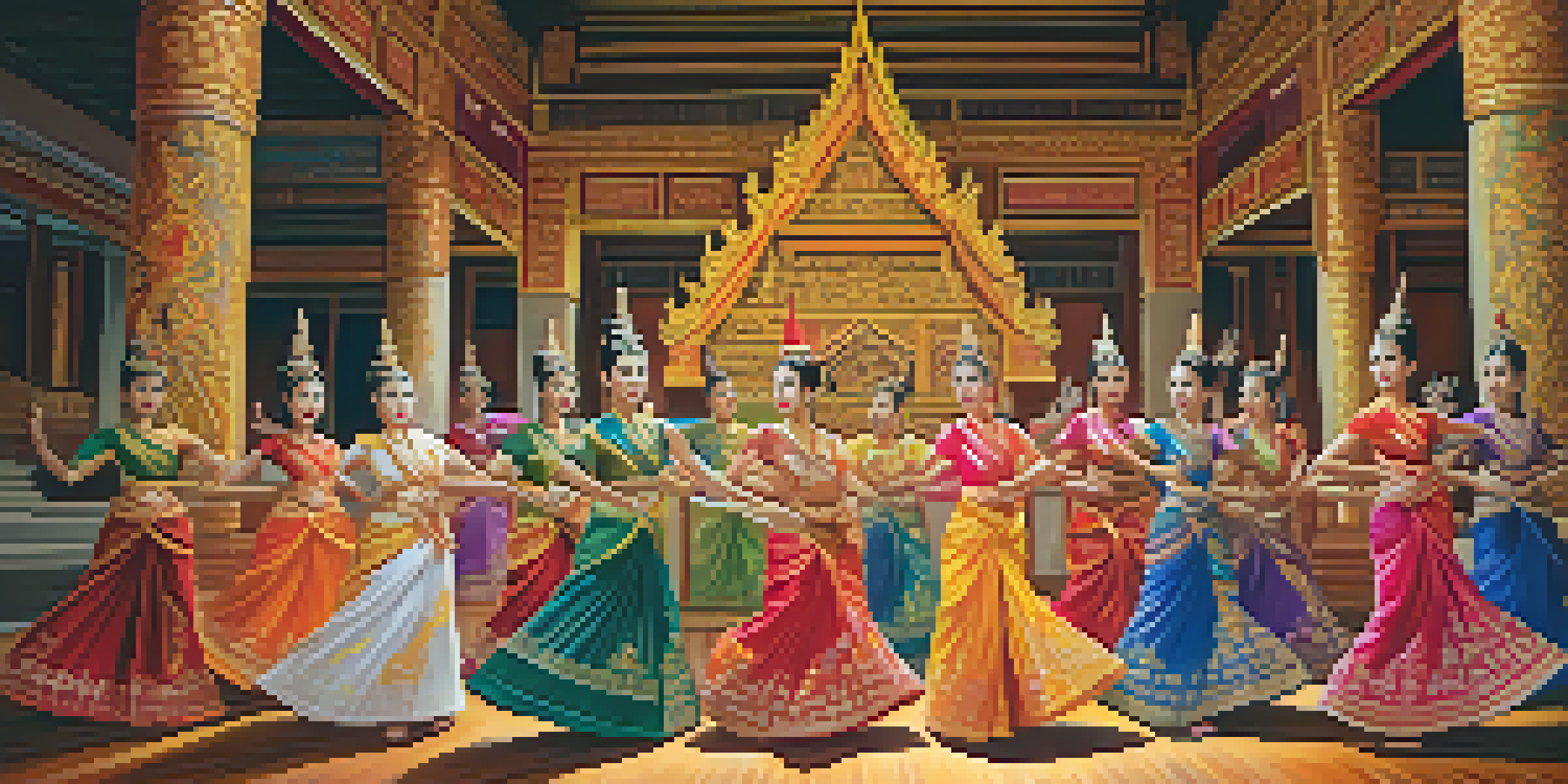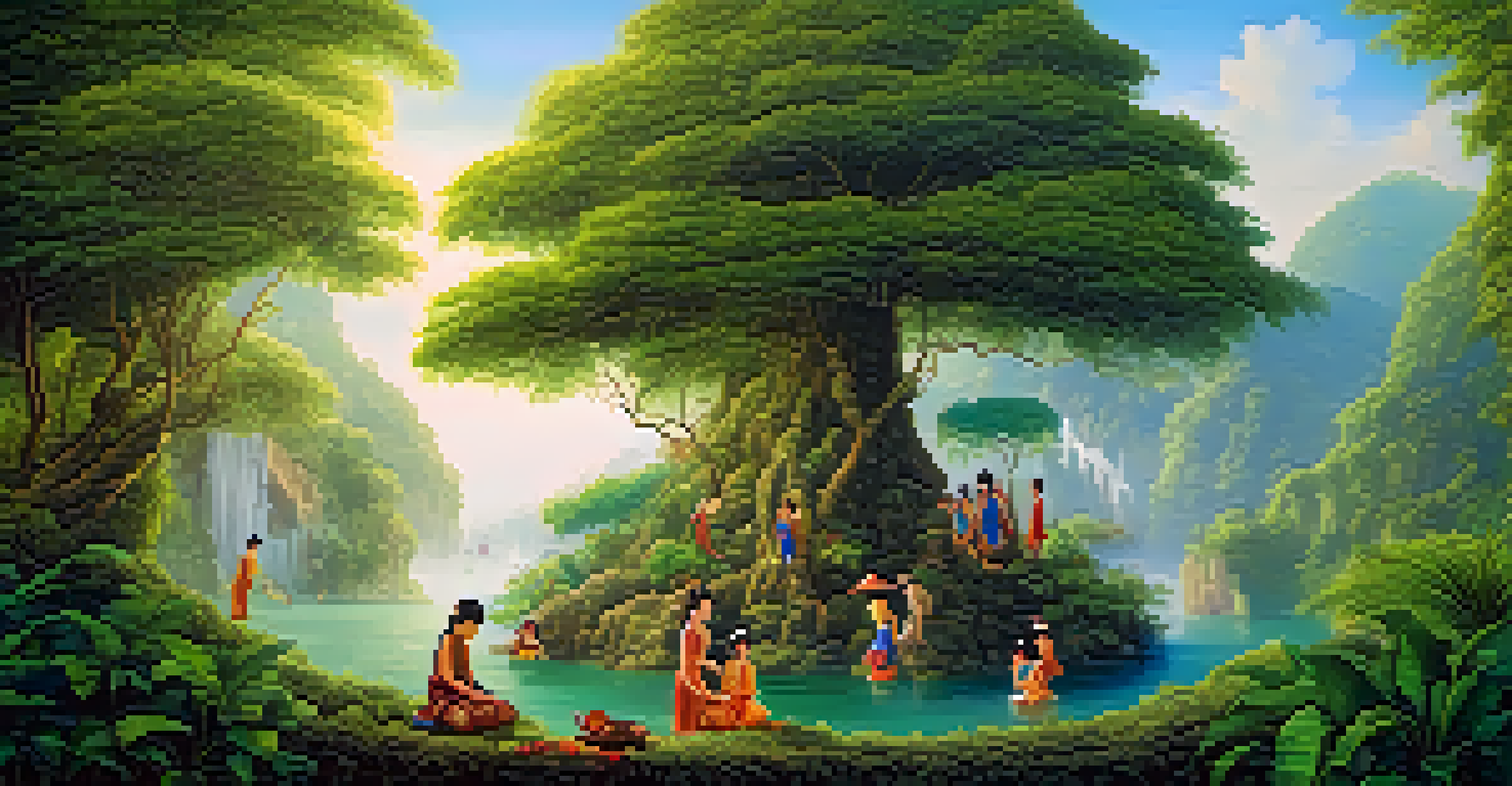The Influence of Traditional Thai Arts on Modern Cinema

Understanding Traditional Thai Arts and Their Significance
Traditional Thai arts encompass various forms, including dance, music, and visual arts, each reflecting the rich cultural heritage of Thailand. These art forms often narrate historical tales, express spiritual beliefs, and convey the essence of Thai identity. By understanding the roots of these traditions, we can appreciate their relevance in contemporary contexts, particularly in cinema.
Art is the most beautiful of all lies; it is the most faithful of all truths.
For instance, classical Thai dance, known as 'Khon,' showcases intricate movements and vibrant costumes that tell stories of ancient epics. The mesmerizing performances are not just entertainment but are deeply tied to Thailand's cultural identity. This connection between art and culture lays a foundation for filmmakers to draw inspiration from these traditions.
As modern cinema increasingly seeks authenticity, the integration of traditional Thai arts offers filmmakers a way to connect with audiences on a deeper level. It's fascinating to see how these ancient art forms can still resonate in today’s storytelling, enriching the cinematic experience.
The Role of Thai Dance in Film Narratives
Thai dance plays a pivotal role in shaping the narratives of many modern films, serving as both a storytelling technique and a visual feast. When filmmakers incorporate traditional dance, they often enhance the emotional depth and cultural context of their stories. This approach not only captivates viewers but also educates them about Thai culture.

Take, for example, the film 'Ong-Bak', which features Muay Thai as not just a fighting style but as an art form that reflects Thai values and spirit. The choreography in such films is meticulously crafted to showcase the beauty and grace of traditional dance, making it an integral part of the film's identity. This blend of action and art creates a unique viewing experience that stands out in the global cinema landscape.
Traditional Arts Shape Thai Cinema
Traditional Thai arts, including dance and music, significantly influence modern cinema by enriching storytelling and enhancing cultural authenticity.
Moreover, incorporating dance allows filmmakers to evoke powerful emotions and connect with audiences on a personal level. The rhythmic movements and visual storytelling bring forth a sense of nostalgia and pride, reminding viewers of their cultural roots while enjoying a modern cinematic experience.
Visual Arts and Cinematic Aesthetics
The influence of traditional Thai visual arts—such as painting and sculpture—can be seen in the aesthetics of modern cinema. From the intricate designs of traditional masks to the vibrant colors often used in Thai art, filmmakers draw upon these elements to create visually stunning scenes. This not only enhances the film's beauty but also reinforces cultural authenticity.
Culture is the widening of the mind and of the spirit.
Many filmmakers utilize traditional motifs and patterns in set designs and costumes, which help to transport audiences into the heart of Thai culture. For instance, films like 'The King and I' have beautifully depicted traditional Thai architecture and art, making the cultural backdrop a character in its own right. This integration highlights the importance of aesthetics in storytelling.
Furthermore, the use of visual arts in cinema can serve as a bridge between the past and present, allowing modern audiences to appreciate and understand traditional Thai culture. As filmmakers continue to explore these artistic influences, they foster a greater appreciation for the rich heritage of Thailand in a contemporary context.
Music as a Cultural Connector in Modern Films
Music is another vital component of traditional Thai arts that significantly influences modern cinema. The use of traditional Thai musical instruments, such as the 'ranat' and 'khim,' adds an authentic soundscape to films. This incorporation not only enriches the viewing experience but also helps convey the emotional nuances of the story.
For example, in films like 'The Legend of King Naresuan,' traditional music is used to enhance the dramatic moments and evoke national pride. The melodies and rhythms resonate with audiences, tapping into their cultural memories and emotions. This connection between music and narrative helps create a powerful cinematic experience.
Folklore Inspires Modern Narratives
Contemporary films often weave themes from Thai folklore into their narratives, keeping the spirit of cultural stories alive while appealing to diverse audiences.
Moreover, the fusion of traditional and contemporary music styles in films allows for innovation while honoring cultural roots. By blending genres, filmmakers can appeal to a broader audience while keeping traditional sounds alive, making the music a vital link between generations.
Thematic Elements from Thai Folklore in Cinema
Thai folklore is rich with stories, myths, and moral lessons that provide a treasure trove of inspiration for filmmakers. Many modern films incorporate these themes, exploring concepts such as love, sacrifice, and the battle between good and evil. By weaving these narratives into contemporary stories, filmmakers keep the spirit of Thai folklore alive.
For example, films like 'The Ghost of Mae Nak' draw upon well-known folklore, adding a layer of familiarity for local audiences while intriguing international viewers. These stories often include elements of fantasy and moral lessons that resonate across cultures, making them relevant even in modern settings.
Incorporating folklore not only serves to entertain but also educates audiences about Thai culture and its values. This integration of traditional themes into modern cinema creates a dialogue between the past and present, allowing filmmakers to explore timeless human experiences through a culturally rich lens.
Preserving Cultural Heritage through Film
As modern cinema evolves, there is a growing concern over the preservation of traditional Thai arts and their cultural significance. Filmmakers have a unique opportunity to document and celebrate these art forms, ensuring they are not lost to time. By showcasing these traditions in films, they contribute to the cultural dialogue and raise awareness about the importance of heritage.
Movies that highlight traditional arts can inspire younger generations to appreciate and engage with their cultural roots. For example, films that focus on traditional crafts, music, or dance help spark interest and pride in Thai culture among youth. This connection can foster a sense of identity and belonging, which is crucial in our rapidly changing world.
Preserving Heritage Through Film
Filmmakers play a crucial role in preserving traditional Thai arts by showcasing them in cinema, fostering cultural pride and identity among younger generations.
Furthermore, by promoting traditional arts through cinema, filmmakers can attract international audiences who may be curious about Thai culture. This exposure not only benefits the film industry but also helps preserve and promote Thailand's rich cultural heritage on a global stage.
The Global Influence of Thai Cinema
The impact of traditional Thai arts on modern cinema extends beyond Thailand, influencing filmmakers around the world. As international audiences become more interested in diverse storytelling, traditional Thai elements offer fresh perspectives that enrich global cinema. The unique blend of culture, art, and narrative found in Thai films can inspire filmmakers everywhere.
Films like 'Uncle Boonmee Who Can Recall His Past Lives' showcase how traditional Thai aesthetics and storytelling can captivate global audiences. By incorporating elements of Thai culture, these films contribute to a broader understanding of the human experience, highlighting the universality of themes such as love, loss, and redemption.

As Thai cinema continues to gain recognition on the international stage, the influence of traditional arts will undoubtedly shape future films. This cross-cultural exchange not only elevates Thai cinema but also promotes a global appreciation for diversity in storytelling.